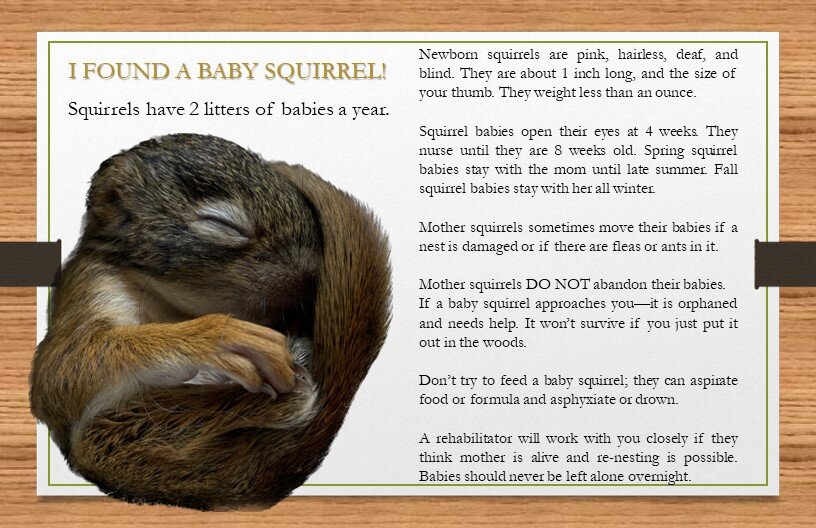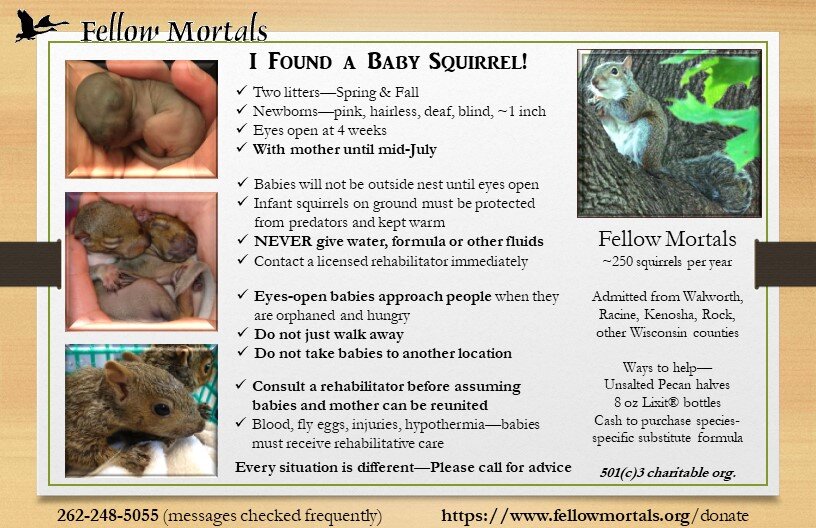By Yvonne Wallace Blane | Project Leader
Every year we get a call, or two, from someone who has discovered a nest of squirrels in their engine compartment, but in 2024, nearly ALL of the 40 squirrels we have in care were discovered in cars or trucks.
Every time we receive a call about squirrels found seemingly orphaned, or in a strange place, like an engine compartment, on their ground, in a gutter, etc., we always ask specific questions to find out if mom might be around and simply moving her babies.
Squirrels generally have two nests, often one is a secure cavity nest in a tree or an attic, and another is a leaf nest, which is more flimsy. Nests can unfortunately become infested with fleas or lice, and mother squirrel will move her babies when this happens.
If she doesn't have a ready nest, she may 'park' them around your yard while she goes about looking for a suitable new home. This is why we don't automatically have finders bring the babies to us right away. We ask them, instead, to gather the babies together in a deep box that they can't leave on their own, put the box up off the ground so that it is safe from cats, and then watch to see if mom returns for her babies.
If mother squirrel doesn't return before dark, she will not retrieve them during the night. Squirrels are diurnal, active during the daytime. If mother doesn't return, you need to call a wildlife rehabilitator right away to get the babies into care.
This year, we have had complications letting mother squirrel retrieve her babies because often they aren't discovered until the car is driven many miles to a garage or to work, and then the frightened mother runs out from under the hood into a strange neighborhood. In these instances, the only option is to leave the vehicle and babies at the garage and hope mother will return, but often that isn't possible when people need their cars to return home.
The best way to prevent this kind of family separation is to Check your Engines before you leave home. Open up that engine compartment and check for leaves or grass under the hood. If you find evidence of nest, call a wildlife rehabilitator right away so that they can help you make a plan to get mother squirrel to move her babies.
Happy Spring Everyone!
By Yvonne Wallace Blane | Co-founder, Fellow Mortals
By Yvonne Wallace Blane | Co-founder, Fellow Mortals
Project reports on GlobalGiving are posted directly to globalgiving.org by Project Leaders as they are completed, generally every 3-4 months. To protect the integrity of these documents, GlobalGiving does not alter them; therefore you may find some language or formatting issues.
If you donate to this project or have donated to this project, you can recieve an email when this project posts a report. You can also subscribe for reports without donating.
Support this important cause by creating a personalized fundraising page.
Start a Fundraiser
